|
|
|



MARY I, Queen of England, unpleasantly remembered as "the Bloody Mary" on account of the religious persecutions which prevailed during her reign,
was the daughter of Henry VIII and Catherine of Aragon, born
in the earlier years of their married life, when as yet no cloud had darkened the prospect of Henry's reign. Her birth occurred at
Greenwich, on Monday, the 18th February 1516, and she was baptized on the following
Wednesday, Cardinal Wolsey standing as her godfather.
She seems to have been a singularly precocious child, and is reported in July 1520, when scarcely four and a half years old, as entertaining some visitors
by a performance on the virginals. When she was little over nine she was addressed in a complimentary Latin oration by commissioners sent over from Flanders
on commercial matters, and replied to them in the same language "with as much assurance and facility as if she had been twelve years old".1
Her father was proud of her achievements. About the same time that she replied to the commissioners in Latin he was arranging that she should learn Spanish,
Italian and French. A great part, however, of the credit of her early education was undoubtedly due to her mother, who not only consulted the Spanish scholar
Vives upon the subject, but was herself Mary's first teacher in Latin. She was also well instructed in music, and among her principal recreations as she grew
up was that of playing on the virginals and lute.
It was a misfortune that she shared with high-born ladies generally in those days that her prospects in life were made a matter of sordid bargaining from the
first. Mary was little more than two years old when she was proposed in marriage to the dauphin, son of Francis I.
Three years afterwards the French alliance was broken off, and in 1522 she was affianced to her cousin the young emperor Charles V
by the Treaty of Windsor. No one, perhaps, seriously expected either of these arrangements to endure; and, though we read in grave state papers of some curious
compliments and love tokens (really the mere counters of diplomacy) professedly sent by the girl of nine to her powerful cousin, not many years passed away
before Charles released himself from this engagement and made a more convenient match.
| | 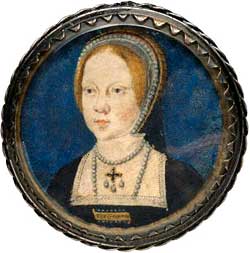
Lady Mary, c. 1521-1525.
By Lucas Horenbout. NPG.
|
In 1526 a rearrangement was made of the royal household, and it was thought right to give Mary an establishment of her own along with a council on the borders
of Wales, for the better government of the Marches. For some years she accordingly kept her court at Ludlow, while new arrangements were made for the disposal
of her hand. She was now proposed as a wife, not for the dauphin as before, but for his father Francis I,
who had just been redeemed from captivity at Madrid, and who was only too glad of an alliance with England to mitigate the severe conditions imposed on him by
the emperor. Wolsey, however, on this occasion, only made use of the princess as a bait to enhance the terms of the compact, and left Francis free in the end to
marry the emperor's sister.
It was during this negotiation, as Henry afterwards pretended, that the question was first raised whether Henry's own marriage with Catherine was a lawful one.
Grammont, Bishop of Tarbes, who was one of the ambassadors sent over by Francis to ask the princess in marriage, had, it was said, started an objection that she
might possibly be considered illegitimate on account of her mother having been once the wife of her father's brother. The statement was a mere pretence to shield
the king when the unpopularity of the divorce became apparent. It is proved to be untrue by the strongest evidence, for we have pretty full contemporary records
of the whole negotiation. On the contrary, it is quite clear that Henry, who had already for some time conceived the project of a divorce, kept the matter a dead
secret, and was particularly anxious that the French ambassadors should not know it, while he used his daughter's hand as a bait for a new alliance. The alliance
itself, however, was actually concluded by a treaty dated Westminster, the 30th of April 1527, in which it was provided, as regards the Princess Mary, that she
should be married either to Francis himself or to his second son Henry Duke of Orleans. But the real object was only to lay the foundation of a perfect mutual
understanding between the two kings, which Wolsey soon after went into France to confirm.
During the next nine years the life of Mary, as well as that of her mother, was rendered miserable by the conduct of Henry VIII in seeking a divorce. During most
of that period mother and daughter seem to have been kept apart. Possibly Queen Catherine had the harder trial; but Mary's was scarcely less severe. Removed from
court and treated as a bastard, she was, on the birth of Anne Boleyn's daughter [Elizabeth],
required to give up the dignity of princess and acknowledge the illegitimacy of her own birth. On her refusal her household was broken up, and she was sent to
Hatfield to act as lady-in-waiting to her own infant half-sister. Nor was even this the worst
of her trials; her very life was in danger from the hatred of Anne Boleyn. Her health, moreover, was indifferent, and even when she was seriously ill, although
Henry sent his own physician, Dr Buttes, to attend her, he declined to let her mother visit her. So also at her mother's death, in January 1536, she was forbidden
to take a last farewell of her.
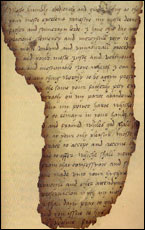 But in May following another change occurred. Anne Boleyn, the real cause of all her miseries, fell under the king's displeasure and was put to death. Mary was then
urged to make a humble submission to her father as the means of recovering his favour, and after a good deal of correspondence2 with the king's secretary,
Cromwell, she actually did so. The terms exacted of her were bitter in the extreme, but there was
no chance of making life tolerable otherwise, if indeed she was permitted to live at all; and the poor friendless girl, absolutely at the mercy of a father who could
brook no contradiction, at length subscribed an act of submission, acknowledging the king as "Supreme Head of the Church of England
under Christ," repudiating the pope's authority, and confessing that the marriage between her father and mother "was by God's law and man's law incestuous and unlawful."
No act, perhaps, in the whole of Henry's reign gives us a more painful idea of his revolting despotism.
But in May following another change occurred. Anne Boleyn, the real cause of all her miseries, fell under the king's displeasure and was put to death. Mary was then
urged to make a humble submission to her father as the means of recovering his favour, and after a good deal of correspondence2 with the king's secretary,
Cromwell, she actually did so. The terms exacted of her were bitter in the extreme, but there was
no chance of making life tolerable otherwise, if indeed she was permitted to live at all; and the poor friendless girl, absolutely at the mercy of a father who could
brook no contradiction, at length subscribed an act of submission, acknowledging the king as "Supreme Head of the Church of England
under Christ," repudiating the pope's authority, and confessing that the marriage between her father and mother "was by God's law and man's law incestuous and unlawful."
No act, perhaps, in the whole of Henry's reign gives us a more painful idea of his revolting despotism.
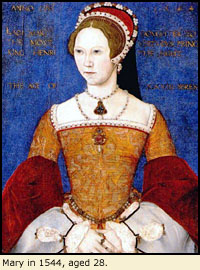 Mary was a high-spirited girl, and
undoubtedly popular. All Europe looked upon her at that time as the only legitimate child of her father, but her father himself compelled her to disown the title and
pass an unjust stigma on her own birth and her mother's good name. Nevertheless Henry was now reconciled to her, and gave her a household in some degree suitable to
her rank. During the rest of the reign we hear little about her except in connexion with a number of new marriage projects taken up and abandoned successively, one
of which, to the count palatine Philip, duke of Bavaria, was specially repugnant to her in the matter of religion. Her privy purse expenses for nearly the whole of
this period have been published, and show that Hatfield, Beaulieu or Newhall in Essex, Richmond and
Hunsdon were among her principal places of residence. Although she was still treated as of illegitimate birth, it was believed that the king, having obtained from
parliament the extraordinary power to dispose of the crown by will, would restore her to her place in the succession, and three years before his death she was so
restored by statute, but still under conditions to be regulated by her father's will. Mary was a high-spirited girl, and
undoubtedly popular. All Europe looked upon her at that time as the only legitimate child of her father, but her father himself compelled her to disown the title and
pass an unjust stigma on her own birth and her mother's good name. Nevertheless Henry was now reconciled to her, and gave her a household in some degree suitable to
her rank. During the rest of the reign we hear little about her except in connexion with a number of new marriage projects taken up and abandoned successively, one
of which, to the count palatine Philip, duke of Bavaria, was specially repugnant to her in the matter of religion. Her privy purse expenses for nearly the whole of
this period have been published, and show that Hatfield, Beaulieu or Newhall in Essex, Richmond and
Hunsdon were among her principal places of residence. Although she was still treated as of illegitimate birth, it was believed that the king, having obtained from
parliament the extraordinary power to dispose of the crown by will, would restore her to her place in the succession, and three years before his death she was so
restored by statute, but still under conditions to be regulated by her father's will.
Under the reign of her brother, Edward VI, she was again subjected to severe trials, which at
one time made her seriously meditate taking flight and escaping abroad. Edward himself indeed seems to have been personally not unkind to her, but the religious
revolution in his reign assumed proportions such as it had not done before, and Mary, who had done sufficient violence to her own convictions in submitting to a
despotic father, was not disposed to yield an equally tame obedience to authority exercised by a factious council in the name of a younger brother not yet come
to years of discretion. Besides, the cause of the pope was naturally her own. In spite of the forced declaration formerly wrung from herself, no one really regarded
her as a bastard, and the full recognition of her rights depended on the recognition of the pope as head of the Church. Hence, when Edward's parliament passed an
Act of Uniformity enjoining services in English and communion in both kinds, the law appeared to her totally void of authority, and she insisted on having Mass in
her own private chapel under the old form. When ordered to desist, she appealed for protection to the emperor Charles V,
who, being her cousin, intervened for some time not ineffectually, threatening war with England if her religious liberty was interfered with.
But Edward's court was composed of factions of which the most violent eventually carried the day. Thomas Seymour, the Lord High Admiral,
was attainted of treason and beheaded in 1549. His brother, the Protector Somerset, met with the same
fate in 1552. John Dudley, Duke of Northumberland, then became paramount in the privy council,
and easily obtained the sanction of the young king to those schemes for altering the succession which led immediately after his death to the usurpation of
Lady Jane Grey [see Edward VI's 'Devise for the Succession].
Dudley, had in fact, overawed all the rest of the privy council, and when the event occurred he took such energetic measures to give effect to the scheme that Lady Jane
was actually recognized as queen for some days, and Mary had even to fly from Hunsdon into Norfolk. But the country was really devoted to her cause, as indeed her right
in law was unquestionable, and before many days she was royally received in London, and took up her abode within the Tower.
Her first acts at the beginning of her reign displayed a character very different from that which she still holds in popular estimation. Her clemency towards those
who had taken up arms against her was altogether remarkable. She released from prison Lady Jane's father, Suffolk, and had difficulty even
in signing the warrant for the execution of Northumberland. Lady Jane herself she fully meant to spare, and did spare till after Wyatt's
formidable insurrection. Her conduct, indeed, was in every respect conciliatory and pacific, and so far as they depended on her personal character the prospects of the
new reign might have appeared altogether favourable. But unfortunately her position was one of peculiar difficulty, and the policy on which she determined was far from
judicious. Inexperienced in the art of governing, she had no trusty councillor but Gardiner; every
other member of the council had been more or less implicated in the conspiracy against her. And though she valued Gardiner's advice she was naturally led to rely even
more on that of her cousin, the emperor [Charles V], who had been her mother's friend in adversity, and had done such material service to
herself in the preceding reign. Following the emperor's guidance she determined almost from the first to make his son Philip her husband,
though she was eleven years his senior. She was also strongly desirous of restoring the old religion and wiping out the stigma of illegitimacy upon her birth, so that
she might not seem to reign by virtue of a mere parliamentary settlement.
Each of these different objects was attended by difficulties or objections peculiar to itself; but the marriage was the most unpopular of all. A restoration of the old
religion threatened to deprive the new owners of abbey lands of their easy and comfortable acquisitions; and it was only with an express reservation of their interests
that the thing was actually accomplished. A declaration of her own legitimacy necessarily cast a slur on that of her sister Elizabeth, and cut her off from the succession.
But the marriage promised to throw England into the arms of Spain and place the resources of the kingdom at the command of the emperor's son. The Commons sent her a
deputation to entreat that she would not marry a foreigner, and when her resolution was known insurrections broke out in different parts of the country. Suffolk, whose
first rebellion had been pardoned, proclaimed Lady Jane Grey again in Leicestershire, while young Wyatt
raised the county of Kent and, though denied access by London Bridge, led his men round by Kingston to the very gates of London before he was repulsed. In the midst
of the danger Mary showed great intrepidity, and the rebellion was presently quelled; after which, unhappily, she got leave to pursue her own course unchecked. She
married Philip, restored the old religion, and got Cardinal Pole
to come over and absolve the kingdom from its past disobedience to the Holy See.
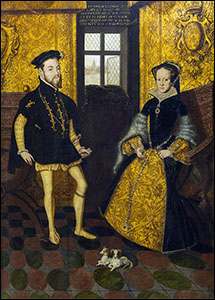 It
was a more than questionable policy thus to ally England with Spain— a power then actually at war with France. By the treaty, indeed, England was to remain neutral;
but the force of events, in the end, compelled her, as might have been expected, to take part in the quarrel. Meanwhile the country was full of faction, and seditious
pamphlets of Protestant origin inflamed the people with hatred against the Spaniards. Philip's Spanish followers met with positive ill-usage everywhere, and violent
outbreaks occurred. A year after his marriage Philip went over to Brussels to receive from his father the government of the Low Countries and afterwards the kingdom
of Spain. Much to Mary's distress, his absence was prolonged for a year and a half, and when he returned in March 1557 it was only to commit England completely to the war;
after which he went back to Brussels in July, to return no more to England. It
was a more than questionable policy thus to ally England with Spain— a power then actually at war with France. By the treaty, indeed, England was to remain neutral;
but the force of events, in the end, compelled her, as might have been expected, to take part in the quarrel. Meanwhile the country was full of faction, and seditious
pamphlets of Protestant origin inflamed the people with hatred against the Spaniards. Philip's Spanish followers met with positive ill-usage everywhere, and violent
outbreaks occurred. A year after his marriage Philip went over to Brussels to receive from his father the government of the Low Countries and afterwards the kingdom
of Spain. Much to Mary's distress, his absence was prolonged for a year and a half, and when he returned in March 1557 it was only to commit England completely to the war;
after which he went back to Brussels in July, to return no more to England.
Hostilities with France were inevitable, because France had encouraged disaffection among Mary's subjects, even during the brief truce of Vaucelles. Conspiracies had
been hatched by English refugees in Paris, and an attempt to seize Scarborough had been made with the aid of vessels from the Seine. But perhaps the strangest thing
about the situation was that the pope took part with France against Spain; and so the very marriage which Mary had contracted to bring England back to the Holy See
made her the wife of the pope's enemy. It was, moreover, this war with France that occasioned the final calamity of the loss of Calais, which sank so deeply into
Mary's heart some time before she died.
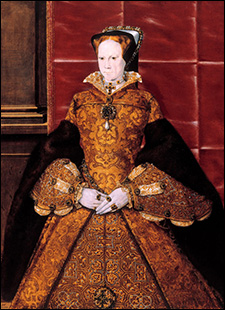 The cruel persecution of the Protestants, which has cast so much infamy upon her reign, was not due, as commonly supposed, to inhumanity on her part. When the kingdom was reconciled to Rome and absolved by Cardinal Pole, it followed, almost as a matter of necessity, that the old heresy laws should be revived, as they were then by Act of Parliament. They had been abolished by the Protector Somerset for the express purpose of promoting changes of doctrine which did violence to what was still the prevailing religious sentiment; and now the old religion required to be protected from insult and fanatical outrages. Doubts were felt as to the result even from the first; but the law having been once passed could not be relaxed merely because the victims were so numerous; for that would only have encouraged the irreverence which it was intended to check. No doubt there were milder men among the heretics, but as a class their stern fanaticism and ill-will to the old religion made them dangerous, even to the public peace. Rogers, the first of the martyrs, was burnt on the 4th of February 1555. Hooper, Bishop of Gloucester, had been condemned six days before, and suffered the same fate upon the 9th. From this time the persecution went on uninterrupted for three years and three quarters, numbering among its victims Ridley, Latimer and Cranmer. It came to an end at last on the death of Mary. It seems to have been more severe in the eastern and southern parts of England, and the largest number of sufferers was naturally in the diocese of Bonner, Bishop of London. From first to last nearly three hundred victims are known to have perished at the stake; and their fate certainly created a revulsion against Rome that nothing else was likely to have effected.
The cruel persecution of the Protestants, which has cast so much infamy upon her reign, was not due, as commonly supposed, to inhumanity on her part. When the kingdom was reconciled to Rome and absolved by Cardinal Pole, it followed, almost as a matter of necessity, that the old heresy laws should be revived, as they were then by Act of Parliament. They had been abolished by the Protector Somerset for the express purpose of promoting changes of doctrine which did violence to what was still the prevailing religious sentiment; and now the old religion required to be protected from insult and fanatical outrages. Doubts were felt as to the result even from the first; but the law having been once passed could not be relaxed merely because the victims were so numerous; for that would only have encouraged the irreverence which it was intended to check. No doubt there were milder men among the heretics, but as a class their stern fanaticism and ill-will to the old religion made them dangerous, even to the public peace. Rogers, the first of the martyrs, was burnt on the 4th of February 1555. Hooper, Bishop of Gloucester, had been condemned six days before, and suffered the same fate upon the 9th. From this time the persecution went on uninterrupted for three years and three quarters, numbering among its victims Ridley, Latimer and Cranmer. It came to an end at last on the death of Mary. It seems to have been more severe in the eastern and southern parts of England, and the largest number of sufferers was naturally in the diocese of Bonner, Bishop of London. From first to last nearly three hundred victims are known to have perished at the stake; and their fate certainly created a revulsion against Rome that nothing else was likely to have effected.
Mary was of weak constitution and subject to frequent illnesses, both before and after her accession. One special infirmity caused her to believe a few months after her marriage that she was with child, and thanksgiving services were ordered throughout the diocese of London in November 1554. The same delusion recurred in March 1558, when though she did not make her expectation public, she drew up a will in anticipation of the dangers of childbirth, constituting her husband regent during the minority of her prospective heir. To this she added a codicil on the 28th of October following, when the illness that was to be her last had set in, showing that she had ceased to have much expectation of maternity, and earnestly entreating her "next heir and successor by the laws" (whom she did not name) to allow execution of the instrument. She died on the 17th of November.
Her name deserved better treatment than it has generally met with; for she was far from cruel. Her kindness to poor people is undoubted, and the severe execution of her laws seemed only a necessity. Even in this matter, moreover, she was alive to the injustice with which the law was usually strained in behalf of the prerogative; and in appointing Sir Richard Morgan chief justice of the Common Pleas she charged him "not to sit in judgment otherwise for her highness than for her subjects,"2 and to avoid the old error of refusing to admit witnesses against the Crown. Her conduct as queen was certainly governed by the best possible intentions; and it is evident that her very zeal for goodness caused most of the trouble she brought upon herself. Her subjects were entirely released, even by papal authority, from any obligation to restore the confiscated lands of the Church. But she herself made it an object, at her own expense, to restore several of the monasteries; and courtiers who did not like to follow her example, encouraged the fanatics to spread an alarm that it would even yet be made compulsory. So the worldly minded joined hands with the godly heretics in stirring up enmity against her.
(James Gairdner)
1 Gayangos, iii. pt. 1, 82
2 Holinshed III, 1112
Excerpted from:
Encyclopedia Britannica, 11th Ed., vol. XVII.
Cambridge: Cambridge University Press, 1910. 816.
 |
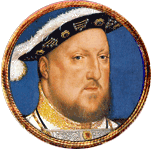
Father
Henry VIII |
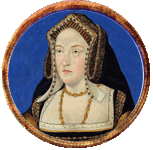
Mother
Catherine Aragon |
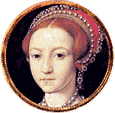
Sister
Elizabeth I |
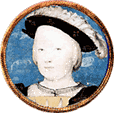
Brother
Edward VI |
Other Local Resources:
Books for further study:
Edwards, John. Mary I: England's Catholic Queen.
New Haven, CT: Yale University Press, 2013.
Elton, G. R. England Under the Tudors.
London: Routledge, 1991.
Erickson, Carolly. Bloody Mary.
New York: St.Martin's Griffin, 1998.
Ridley, Jasper. Bloody Mary's Martyrs: The Story of England's Terror.
New York: Carroll & Graf Publishers, 2002.
Samson, Alexander. Mary and Philip: The Marriage of Tudor England and Habsburg Spain.
Manchester: Manchester University Press, 2022.
Schutte, V. and J. S. Hower, eds. Mary I in Writing: Letters, Literature, and Representation.
Cham, Switzerland: Palgrave Macmillan, 2022.
Tittler, Robert. The Reign of Mary I.
London: Longman's, 1991.
Weir, Alison. The Children of Henry VIII.
New York: Ballantine Books, 1997.
Queen Mary I on the Web:
Article Citation:
"Mary I." 1911 Encyclopedia Britannica.
Excerpted at Luminarium.
10 Apr 2012. [Date when you accessed the page].
<http://www.luminarium.org/encyclopedia/queenmary.htm>
 | to Henry VIII |
 | to Elizabeth I |
 | to Renaissance English Literature |
 | to Luminarium Encyclopedia |
|
Index of Encyclopedia Entries:
Medieval Cosmology
Prices of Items in Medieval England
Edward II
Isabella of France, Queen of England
Piers Gaveston
Thomas of Brotherton, E. of Norfolk
Edmund of Woodstock, E. of Kent
Thomas, Earl of Lancaster
Henry of Lancaster, Earl of Lancaster
Henry of Grosmont, Duke of Lancaster
Roger Mortimer, Earl of March
Hugh le Despenser the Younger
Bartholomew, Lord Burghersh, elder
Hundred Years' War (1337-1453)
Edward III
Philippa of Hainault, Queen of England
Edward, Black Prince of Wales
John of Eltham, Earl of Cornwall
The Battle of Crécy, 1346
The Siege of Calais, 1346-7
The Battle of Poitiers, 1356
Lionel of Antwerp, Duke of Clarence
John of Gaunt, Duke of Lancaster
Edmund of Langley, Duke of York
Thomas of Woodstock, Gloucester
Richard of York, E. of Cambridge
Richard Fitzalan, 3. Earl of Arundel
Roger Mortimer, 2nd Earl of March
The Good Parliament, 1376
Richard II
The Peasants' Revolt, 1381
Lords Appellant, 1388
Richard Fitzalan, 4. Earl of Arundel
Archbishop Thomas Arundel
Thomas de Beauchamp, E. Warwick
Robert de Vere, Earl of Oxford
Ralph Neville, E. of Westmorland
Thomas Mowbray, Duke of Norfolk
Edmund Mortimer, 3. Earl of March
Roger Mortimer, 4. Earl of March
John Holland, Duke of Exeter
Michael de la Pole, E. Suffolk
Hugh de Stafford, 2. E. Stafford
Henry IV
Edward, Duke of York
Edmund Mortimer, 5. Earl of March
Henry Percy, Earl of Northumberland
Sir Henry Percy, "Harry Hotspur"
Thomas Percy, Earl of Worcester
Owen Glendower
The Battle of Shrewsbury, 1403
Archbishop Richard Scrope
Thomas Mowbray, 3. E. Nottingham
John Mowbray, 2. Duke of Norfolk
Thomas Fitzalan, 5. Earl of Arundel
Henry V
Thomas, Duke of Clarence
John, Duke of Bedford
Humphrey, Duke of Gloucester
John Talbot, Earl of Shrewsbury
Richard, Earl of Cambridge
Henry, Baron Scrope of Masham
William de la Pole, Duke of Suffolk
Thomas Montacute, E. Salisbury
Richard Beauchamp, E. of Warwick
Henry Beauchamp, Duke of Warwick
Thomas Beaufort, Duke of Exeter
Cardinal Henry Beaufort
John Beaufort, Earl of Somerset
Sir John Fastolf
John Holland, 2. Duke of Exeter
Archbishop John Stafford
Archbishop John Kemp
Catherine of Valois
Owen Tudor
John Fitzalan, 7. Earl of Arundel
John, Lord Tiptoft
Charles VII, King of France
Joan of Arc
Louis XI, King of France
Charles the Bold, Duke of Burgundy
The Battle of Agincourt, 1415
The Battle of Castillon, 1453
The Wars of the Roses 1455-1485
Causes of the Wars of the Roses
The House of Lancaster
The House of York
The House of Beaufort
The House of Neville
The First Battle of St. Albans, 1455
The Battle of Blore Heath, 1459
The Rout of Ludford, 1459
The Battle of Northampton, 1460
The Battle of Wakefield, 1460
The Battle of Mortimer's Cross, 1461
The 2nd Battle of St. Albans, 1461
The Battle of Towton, 1461
The Battle of Hedgeley Moor, 1464
The Battle of Hexham, 1464
The Battle of Edgecote, 1469
The Battle of Losecoat Field, 1470
The Battle of Barnet, 1471
The Battle of Tewkesbury, 1471
The Treaty of Pecquigny, 1475
The Battle of Bosworth Field, 1485
The Battle of Stoke Field, 1487
Henry VI
Margaret of Anjou
Richard Plantagenet, Duke of York
Edward IV
Elizabeth Woodville
Richard Woodville, 1. Earl Rivers
Anthony Woodville, 2. Earl Rivers
Jane Shore
Edward V
Richard III
George, Duke of Clarence
Ralph Neville, 2. Earl of Westmorland
Richard Neville, Earl of Salisbury
Richard Neville, Earl of Warwick
Edward Neville, Baron Bergavenny
William Neville, Lord Fauconberg
Robert Neville, Bishop of Salisbury
John Neville, Marquis of Montagu
George Neville, Archbishop of York
John Beaufort, 1. Duke Somerset
Edmund Beaufort, 2. Duke Somerset
Henry Beaufort, 3. Duke of Somerset
Edmund Beaufort, 4. Duke Somerset
Margaret Beaufort
Edmund Tudor, Earl of Richmond
Jasper Tudor, Earl of Pembroke
Humphrey Stafford, D. Buckingham
Henry Stafford, Duke of Buckingham
Humphrey Stafford, E. of Devon
Thomas, Lord Stanley, Earl of Derby
Sir William Stanley
Archbishop Thomas Bourchier
Henry Bourchier, Earl of Essex
John Mowbray, 3. Duke of Norfolk
John Mowbray, 4. Duke of Norfolk
John Howard, Duke of Norfolk
Henry Percy, 2. E. Northumberland
Henry Percy, 3. E. Northumberland
Henry Percy, 4. E. Northumberland
William, Lord Hastings
Henry Holland, Duke of Exeter
William Fitzalan, Earl of Arundel
William Herbert, 1. Earl of Pembroke
John de Vere, 12th Earl of Oxford
John de Vere, 13th Earl of Oxford
Thomas de Clifford, 8. Baron Clifford
John de Clifford, 9. Baron Clifford
John Tiptoft, Earl of Worcester
Thomas Grey, 1. Marquis Dorset
Sir Andrew Trollop
Archbishop John Morton
Edward Plantagenet, E. of Warwick
John Talbot, 2. E. Shrewsbury
John Talbot, 3. E. Shrewsbury
John de la Pole, 2. Duke of Suffolk
John de la Pole, E. of Lincoln
Edmund de la Pole, E. of Suffolk
Richard de la Pole
John Sutton, Baron Dudley
James Butler, 5. Earl of Ormonde
Sir James Tyrell
Edmund Grey, first Earl of Kent
George Grey, 2nd Earl of Kent
John, 5th Baron Scrope of Bolton
James Touchet, 7th Baron Audley
Walter Blount, Lord Mountjoy
Robert Hungerford, Lord Moleyns
Thomas, Lord Scales
John, Lord Lovel and Holand
Francis Lovell, Viscount Lovell
Sir Richard Ratcliffe
William Catesby
Ralph, 4th Lord Cromwell
Jack Cade's Rebellion, 1450
Tudor Period
King Henry VII
Queen Elizabeth of York
Arthur, Prince of Wales
Lambert Simnel
Perkin Warbeck
The Battle of Blackheath, 1497
King Ferdinand II of Aragon
Queen Isabella of Castile
Maximilian I, Holy Roman Emperor
King Henry VIII
Queen Catherine of Aragon
Queen Anne Boleyn
Queen Jane Seymour
Queen Anne of Cleves
Queen Catherine Howard
Queen Katherine Parr
King Edward VI
Queen Mary I
Queen Elizabeth I
Henry Fitzroy, Duke of Richmond
Margaret Tudor, Queen of Scotland
James IV, King of Scotland
The Battle of Flodden Field, 1513
James V, King of Scotland
Mary of Guise, Queen of Scotland
Mary Tudor, Queen of France
Louis XII, King of France
Francis I, King of France
The Battle of the Spurs, 1513
Field of the Cloth of Gold, 1520
Charles V, Holy Roman Emperor
Eustace Chapuys, Imperial Ambassador
The Siege of Boulogne, 1544
Cardinal Thomas Wolsey
Archbishop Thomas Cranmer
Thomas Cromwell, Earl of Essex
Thomas, Lord Audley
Thomas Wriothesley, E. Southampton
Sir Richard Rich
Edward Stafford, D. of Buckingham
Thomas Howard, 2nd Duke of Norfolk
Thomas Howard, 3rd Duke of Norfolk
John Dudley, Duke of Northumberland
Charles Brandon, Duke of Suffolk
Thomas Boleyn, Earl of Wiltshire
George Boleyn, Viscount Rochford
John Russell, Earl of Bedford
Thomas Grey, 2. Marquis of Dorset
Henry Grey, D. of Suffolk
Charles Somerset, Earl of Worcester
George Talbot, 4. E. Shrewsbury
Francis Talbot, 5. E. Shrewsbury
Henry Algernon Percy,
5th Earl of Northumberland
Henry Algernon Percy,
6th Earl of Northumberland
Ralph Neville, 4. E. Westmorland
Henry Neville, 5. E. Westmorland
William Paulet, Marquis of Winchester
Sir Francis Bryan
Sir Nicholas Carew
John de Vere, 15th Earl of Oxford
John de Vere, 16th Earl of Oxford
Thomas Seymour, Lord Admiral
Edward Seymour, Protector Somerset
Margaret Pole, Countess of Salisbury
Henry Pole, Lord Montague
Sir Geoffrey Pole
Thomas Manners, Earl of Rutland
Henry Manners, Earl of Rutland
Henry Bourchier, 2. Earl of Essex
Robert Radcliffe, 1. Earl of Sussex
Henry Radcliffe, 2. Earl of Sussex
George Hastings, Earl of Huntingdon
Henry Courtenay, Marquis of Exeter
George Neville, Baron Bergavenny
Sir Edward Neville
William, Lord Paget
William Sandys, Baron Sandys
William Fitzwilliam, E. Southampton
Sir Anthony Browne
Sir Thomas Wriothesley
Sir William Kingston
George Brooke, Lord Cobham
Sir Richard Southwell
Thomas Fiennes, 9th Lord Dacre
Sir Francis Weston
Henry Norris
Lady Jane Grey
Sir Thomas Arundel
Sir Richard Sackville
Sir William Petre
Sir John Cheke
Walter Haddon, L.L.D
Sir Peter Carew
Sir John Mason
Nicholas Wotton
John Taylor
Sir Thomas Wyatt, the Younger
Cardinal Lorenzo Campeggio
Cardinal Reginald Pole
Stephen Gardiner, Bishop of Winchester
Edmund Bonner, Bishop of London
Nicholas Ridley, Bishop of London
John Hooper, Bishop of Gloucester
John Aylmer, Bishop of London
Thomas Linacre
William Grocyn
Archbishop William Warham
Cuthbert Tunstall, Bishop of Durham
Richard Fox, Bishop of Winchester
Edward Fox, Bishop of Hereford
Pope Julius II
Pope Leo X
Pope Clement VII
Pope Paul III
Pope Pius V
Pico della Mirandola
Desiderius Erasmus
Martin Bucer
Richard Pace
Christopher Saint-German
Thomas Tallis
Elizabeth Barton, the Nun of Kent
Hans Holbein, the Younger
The Sweating Sickness
Dissolution of the Monasteries
Pilgrimage of Grace, 1536
Robert Aske
Anne Askew
Lord Thomas Darcy
Sir Robert Constable
Oath of Supremacy
The Act of Supremacy, 1534
The First Act of Succession, 1534
The Third Act of Succession, 1544
The Ten Articles, 1536
The Six Articles, 1539
The Second Statute of Repeal, 1555
The Act of Supremacy, 1559
Articles Touching Preachers, 1583
Queen Elizabeth I
William Cecil, Lord Burghley
Robert Cecil, 1st Earl of Salisbury
Sir Francis Walsingham
Sir Nicholas Bacon
Sir Thomas Bromley
Robert Dudley, Earl of Leicester
Ambrose Dudley, Earl of Warwick
Henry Carey, Lord Hunsdon
Sir Thomas Egerton, Viscount Brackley
Sir Francis Knollys
Katherine "Kat" Ashley
Lettice Knollys, Countess of Leicester
George Talbot, 6. E. of Shrewsbury
Elizabeth, Countess of Shrewsbury
Gilbert Talbot, 7. E. of Shrewsbury
Sir Henry Sidney
Sir Robert Sidney
Archbishop Matthew Parker
Walter Devereux, 1st Earl of Essex
Robert Devereux, 2nd Earl of Essex
Penelope Devereux, Lady Rich
Sir Christopher Hatton
Edward Courtenay, E. Devonshire
Edward Manners, 3rd Earl of Rutland
Thomas Radcliffe, 3. Earl of Sussex
Henry Radcliffe, 4. Earl of Sussex
Robert Radcliffe, 5. Earl of Sussex
William Parr, Marquis of Northampton
Henry Wriothesley, 2. Southampton
Henry Wriothesley, 3. Southampton
Charles Neville, 6. E. Westmorland
Thomas Percy, 7. E. Northumberland
Henry Percy, 8. E. Northumberland
Henry Percy, 9. E. Nothumberland
William Herbert, 1. Earl of Pembroke
Charles, Lord Howard of Effingham
Thomas Howard, 4th Duke of Norfolk
Henry Howard, 1. Earl of Northampton
Thomas Howard, 1. Earl of Suffolk
Henry Hastings, 3. E. of Huntingdon
Edward Manners, 3rd Earl of Rutland
Roger Manners, 5th Earl of Rutland
Francis Manners, 6th Earl of Rutland
Henry FitzAlan, 12. Earl of Arundel
Thomas, Earl Arundell of Wardour
Edward Somerset, E. of Worcester
William Davison
Sir Walter Mildmay
Sir Ralph Sadler
Sir Amyas Paulet
Gilbert Gifford
Anthony Browne, Viscount Montague
François, Duke of Alençon & Anjou
Mary, Queen of Scots
Henry Stuart, Lord Darnley
James Hepburn, Earl of Bothwell
Anthony Babington and the Babington Plot
John Knox
Philip II of Spain
The Spanish Armada, 1588
Sir Francis Drake
Sir John Hawkins
William Camden
Archbishop Whitgift
Martin Marprelate Controversy
John Penry (Martin Marprelate)
Richard Bancroft, Archbishop of Canterbury
John Dee, Alchemist
Philip Henslowe
Edward Alleyn
The Blackfriars Theatre
The Fortune Theatre
The Rose Theatre
The Swan Theatre
Children's Companies
The Admiral's Men
The Lord Chamberlain's Men
Citizen Comedy
The Isle of Dogs, 1597
Common Law
Court of Common Pleas
Court of King's Bench
Court of Star Chamber
Council of the North
Fleet Prison
Assize
Attainder
First Fruits & Tenths
Livery and Maintenance
Oyer and terminer
Praemunire
The Stuarts
King James I of England
Anne of Denmark
Henry, Prince of Wales
The Gunpowder Plot, 1605
George Villiers, 1st Duke of Buckingham
Robert Carr, Earl of Somerset
Arabella Stuart, Lady Lennox
William Alabaster
Bishop Hall
Bishop Thomas Morton
Archbishop William Laud
John Selden
Lucy Harington, Countess of Bedford
Henry Lawes
King Charles I
Queen Henrietta Maria
Long Parliament
Rump Parliament
Kentish Petition, 1642
Thomas Wentworth, Earl of Strafford
John Digby, Earl of Bristol
George Digby, 2nd Earl of Bristol
Thomas Fairfax, 3rd Lord Fairfax
Robert Devereux, 3rd E. of Essex
Robert Sidney, 2. E. of Leicester
Algernon Percy, E. of Northumberland
Henry Montagu, Earl of Manchester
Edward Montagu, 2. Earl of Manchester
The Restoration
King Charles II
King James II
Test Acts
Greenwich Palace
Hatfield House
Richmond Palace
Windsor Palace
Woodstock Manor
The Cinque Ports
Mermaid Tavern
Malmsey Wine
Great Fire of London, 1666
Merchant Taylors' School
Westminster School
The Sanctuary at Westminster
"Sanctuary"
Images:
Chart of the English Succession from William I through Henry VII
Medieval English Drama
London c1480, MS Royal 16
London, 1510, the earliest view in print
Map of England from Saxton's Descriptio Angliae, 1579
London in late 16th century
Location Map of Elizabethan London
Plan of the Bankside, Southwark, in Shakespeare's time
Detail of Norden's Map of the Bankside, 1593
Bull and Bear Baiting Rings from the Agas Map (1569-1590, pub. 1631)
Sketch of the Swan Theatre, c. 1596
Westminster in the Seventeenth Century, by Hollar
Visscher's View of London, 1616
Larger Visscher's View in Sections
c. 1690. View of London Churches, after the Great Fire
The Yard of the Tabard Inn from Thornbury, Old and New London
|
|